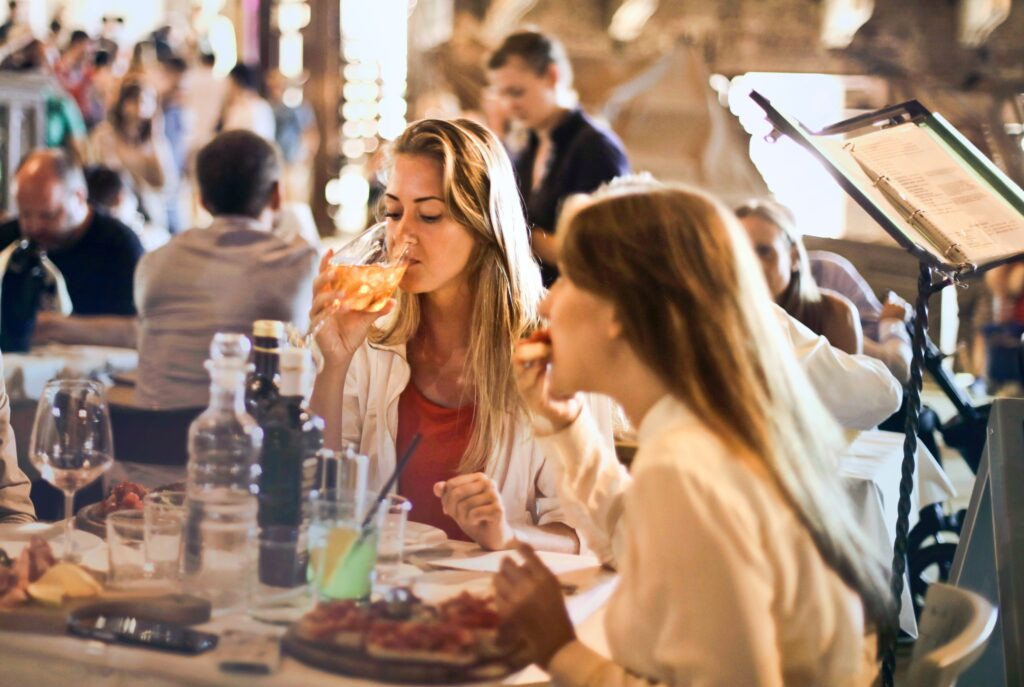 Find Parenting Influencers – A-Z Guide, Criteria, Precautions, Pros, FAQs
Find Parenting Influencers – A-Z Guide, Criteria, Precautions, Pros, FAQs
Restaurant influencing involves individuals creating content to promote and share experiences related to dining establishments. With millions of users engaging in this trend, it significantly impacts the restaurant industry. For brand owners, collaborating with restaurant influencers can amplify product visibility and attract customers by leveraging the influencers’ audience and authentic recommendations, enhancing marketing effectiveness in the competitive culinary landscape.
JoinBrands enables you to connect easily with restaurant influencers to promote your restaurant and/or food products. You can use the several filters available to you to find restaurant influencers that align perfectly with your brand values.
This article guides us through finding restaurant influencers using JoinBrands in 6 steps as well as 5 other methods. You also get a complete 9-step restaurant influencer marketing guide. It highlights 10 key traits of a good influencer, outlines 10 precautions when collaborating, and discusses 10 benefits of such partnerships. FAQs and a conclusion offer additional insights.
Now we will answer: How to Find Restaurant Influencers.

Table of Contents
What is a Restaurant Influencer?
Restaurant influencers are individuals with a significant online presence who showcase and influence dining experiences. Key attributes include culinary expertise, engaging content creation, and a substantial follower base. Three types of restaurant influencers include food critics, chefs, and culinary explorers, etc. They assist brand owners by boosting visibility, enhancing credibility, fostering engagement, and driving product adoption.
Here are the three types of restaurant influencers that can help your brand grow:
- Food Critics: Food critics are influencers known for their detailed and insightful reviews of various dining establishments, suited for brand owners in the hospitality industry seeking critical acclaim and reputation management.
- Chefs: Renowned chefs who influence culinary trends and showcase their expertise, ideal for brand owners in the food and kitchenware industry looking to align with culinary authority.
- Culinary Explorers: Influencers exploring diverse cuisines and sharing their experiences, beneficial for brand owners in the travel and food industries targeting adventurous audiences.
Now, we will discuss how to find these types of restaurant influencers, particularly using JoinBrands, along with a few other methods.
6 Methods to Find Restaurant Influencers
In this section, we will discuss some of the other methods to find restaurant influencers. We will include the overview, tools used and step by step procedure so you can promote your brand or sell products effectively through influencer marketing.
Let’s review 6 methods in detail.
Method 1: Finding Restaurant Influencers with JoinBrands (Best & Most Recommended)
JoinBrands offers a straightforward process for you to connect seamlessly with restaurant influencers. You can use several criteria such as product details, content type, and more to find restaurant influencers that align best with your brand goals.
Here are the 6 steps to find restaurant Influencers using JoinBrands:
- Sign Up on JoinBrands: Register as a brand.
- Start a Campaign: Choose between ‘UGC Images: Content only’ for restaurant images or ‘UGC Videos: Content Only’ for restaurant videos.
- Add Product Information: Include details like type, name, price, industry, and an external link, along with an image.
- Choose Delivery Option: Decide between reimbursement or direct delivery to restaurant influencers.
- Customize Creator Demographics: Select specific restaurant influencer demographics like gender, age, and ethnicity.
- Review and Create Your Campaign: Finalize your choices and launch the campaign.
The significance of this method lies in its customization capabilities, enabling brand owners to precisely target the types of restaurant influencers that align best with their brand’s image and audience.
In order to have a step by step (image based guide) to find restaurant influencers on JoinBrands, click here.
Now we will look at the next item on the list, finding restaurant influencers on social media platforms.
Method 2: Social Media Platforms for Finding Restaurant Influencers
Social media platforms like Instagram, Twitter, and Facebook provide a vast landscape to identify restaurant influencers. Their engagement and content relevance on these platforms are key indicators of influence.
Here are the 3 steps:
- Explore relevant hashtags and keywords on Instagram, Twitter, and Facebook.
- Analyze influencer profiles for engagement metrics and content quality.
- Directly message potential restaurant influencers expressing interest in collaboration.
Brands can efficiently discover restaurant influencers with a strong online presence, aligning with their restaurant marketing goals.
Now, let’s explore the second method, Influencer Marketing Platforms.
Method 3: Influencer Marketing Platforms for Discovering Restaurant Influencers
Influencer marketing platforms like JoinBrands offer curated lists of restaurant influencers. Filter options streamline the search for restaurant influencers based on niche, audience size, and engagement.
Here are the 3 steps:
- Sign up on JoinBrands and navigate to the influencer search section.
- Utilize filters to specify criteria such as niche, location, and audience size.
- Review restaurant influencer profiles and metrics before reaching out for collaboration.
This streamlines the restaurant influencer discovery process, ensuring a targeted approach for brand collaboration.
Now, let’s delve into the third method: Collaborative Events and Partnerships.
Method 4: Collaborative Events and Partnerships with Restaurants
Engage with local restaurants and culinary events for influencer collaboration. Establish partnerships to showcase your products within their settings.
Follow these 3 steps:
- Identify local restaurants or culinary events that align with your brand.
- Reach out to them proposing a collaboration to promote your products.
- Discuss mutual benefits, such as co-hosted events or sponsored content.
This fosters authentic partnerships, leveraging the restaurant’s audience for impactful promotions.
Now, let’s move on to Method 4: Social Media Hashtag Search.
Method 5: Social Media Hashtag Search for Restaurant Influencers
Leverage social media platforms by searching for relevant hashtags associated with restaurants. Identify potential restaurant influencers sharing content using these hashtags.
Follow these 3 steps:
- Use platforms like Instagram or Twitter to search for restaurant-related hashtags.
- Explore posts, focusing on restaurant influencers with engaging content.
- Reach out to them with collaboration proposals.
This taps into organic conversations, connecting with restaurant influencers active in restaurant-related discussions.
Now, let’s explore Method 5: Industry Events and Conferences.
Method 6: Industry Events and Conferences for Restaurant Influencers
Participate in industry events and conferences related to the restaurant business. These gatherings attract restaurant influencers and professionals passionate about the culinary world.
Follow these 3 steps:
- Attend restaurant expos, food festivals, or business conferences.
- Identify restaurant influencers present at these events through networking.
- Initiate conversations and propose collaboration opportunities.
This establishes real-time connections, ensuring restaurant influencers share a genuine interest in the restaurant industry.
Now, let’s delve into the steps for finding restaurant influencers using these methods collectively.
The Complete Restaurant Influencer Marketing Guide (9 Easy Steps)
To effectively leverage restaurant influencers, start by defining brand goals and identifying the target audience. Choose platforms relevant to your niche, utilize hashtags, and engage in social listening for organic restaurant influencer discovery. Assess authenticity, content quality, and influencer metrics, focusing on genuine outreach. Finally, establish clear collaboration terms for a successful partnership, ensuring a seamless integration into your restaurant’s marketing strategy.
1. Define Your Brand Goals
To launch a successful restaurant influencer campaign, start by clearly outlining the objectives you aim to achieve, whether it’s boosting brand awareness, driving more foot traffic, or promoting specific products or services. For instance, a new vegan restaurant might prioritize restaurant influencers who align with a plant-based lifestyle, targeting health-conscious customers.
2. Identify Target Audience
Pinpoint your ideal customer demographics and preferences to find restaurant influencers who resonate with them. Analyze customer data to understand age groups, interests, and locations. For example, a family-oriented restaurant seeking restaurant influencers appealing to parents could showcase family-friendly dining experiences.
3. Choose Platform Relevance
Select platforms where your target audience actively engages with restaurant-related content. Analyze social media and review sites to identify popular platforms in your niche. For instance, a trendy dessert spot might prioritize Instagram restaurant influencers known for visually appealing food content.
4. Utilize Hashtags and Keywords
Employ relevant hashtags and keywords to discover restaurant influencers aligned with your restaurant’s theme. Explore trending restaurant-related hashtags and keywords on social media. For example, a seafood restaurant might search for restaurant influencers using hashtags like #SeafoodLovers or #FoodiesOfTheSea.
5. Engage with Social Listening
Monitor conversations and mentions related to your restaurant to discover potential restaurant influencers who organically engage with your brand. This involves actively listening to discussions and comments on social media and review platforms. For instance, a cafe specializing in artisanal coffee might identify influencers who frequently discuss coffee culture and specialty brews.
6. Assess Restaurant Influencer Authenticity
Prioritize restaurant influencers who authentically align with your restaurant’s values and offerings. Verify their authenticity by reviewing their content, engagement patterns, and audience interactions. An authentic restaurant influencer, for instance, could be someone genuinely passionate about promoting local eateries and supporting community businesses.
7. Evaluate Content Quality
Examine the overall quality of a restaurant influencer’s content, including aesthetics, storytelling, and engagement. Consider restaurant influencers whose content aligns with your restaurant’s visual identity and storytelling goals. For example, a high-end restaurant might seek restaurant influencers with a sophisticated and visually appealing content style.
8. Review Restaurant Influencer Metrics
Analyze key metrics such as follower count, engagement rate, and audience demographics to gauge a restaurant influencer’s reach and impact. Prioritize restaurant influencers whose metrics align with your campaign objectives. For instance, a neighborhood pizzeria might benefit from restaurant micro-influencers with a local and engaged following.
9. Initiate Genuine Outreach
Reach out to selected restaurant influencers with personalized and genuine messages, expressing your interest in collaboration. Clearly communicate the value proposition for restaurant influencers partnering with your restaurant. For example, a newly opened bistro could highlight exclusive tastings, behind-the-scenes access, or special promotions for restaurant influencers willing to collaborate.
10. Establish Clear Collaboration Terms
Once restaurant influencers express interest, establish clear and transparent collaboration terms, including expectations, deliverables, and compensation. Formalize agreements through contracts to ensure a professional and mutually beneficial partnership. An upscale restaurant, for instance, might specify content requirements, posting schedules, and compensation details in the contract to ensure a smooth collaboration.
Now that we know how an influencer marketing campaign for a restaurant works, we will explore what makes a good restaurant influencer.
What makes a Good Restaurant Influencer? (10 Things to Consider to Find the Right Restaurant Influencer)
Collaborating with restaurant influencers involves aligning with the right audience, emphasizing authenticity, and monitoring engagement metrics for effective marketing. Relevance to the culinary niche, consistent values, and transparency in collaborations contribute to an authentic representation. Stability in engagement, reliable content delivery, and diverse collaborations ensure a robust marketing approach. Assessing a restaurant influencer’s proven track record provides insights for successful partnerships, minimizing potential conflicts.
1. Audience Alignment
Ensure the restaurant influencer’s audience matches your target demographic for effective marketing. Crucial, as misalignment may lead to poor brand resonance. Example: A family restaurant aligning with restaurant influencers whose followers include families seeking dining options. Conversely, aligning with a restaurant influencer whose audience comprises primarily singles may result in ineffective promotion.
2. Authentic Content
Prioritize restaurant influencers creating content reflecting genuine values, fostering trust. Authenticity is essential for credibility and trustworthiness. Example: A café brand partnering with restaurant influencers who genuinely appreciate and showcase the café experience. On the flip side, restaurant influencers promoting products without genuine connections erode trust.
3. Engagement Metrics
High engagement, measured by likes and comments, signifies impact and reach. Crucial for ensuring maximum visibility and potential product adoption. Example: A dessert brand collaborating with restaurant influencers whose posts consistently receive high engagement, maximizing visibility. Conversely, a restaurant influencer with a large following but minimal engagement may not convey brand messages effectively.
4. Relevance to Culinary Niche
Align with restaurant influencers whose content resonates with your restaurant’s culinary niche. Crucial for effective brand messaging and communication. Example: A vegan restaurant collaborating with restaurant influencers who specialize in creating content around plant-based dining. On the contrary, partnering with a restaurant influencer whose niche is unrelated to culinary experiences may result in misaligned content.
5. Consistent Values
Partner with restaurant influencers sharing consistent values to ensure seamless integration of your restaurant’s offerings into their lifestyle. Contributes to an authentic representation of your brand. Example: A sustainability-focused restaurant collaborating with restaurant influencers who genuinely embrace eco-friendly practices. In contrast, partnering with a restaurant influencer who inconsistently practices sustainability may lead to a disconnection between their personal brand and your restaurant’s values.
6. Transparency in Collaborations
Establish clear and transparent contractual agreements outlining expectations, responsibilities, and deliverables. Ensures a professional working relationship, minimizing misunderstandings. Example: A fine-dining restaurant collaborating with restaurant influencers specifying content requirements, posting schedules, and compensation details in a contract. Failure to adhere can lead to misalignment and negatively impact collaboration success.
7. Engagement Stability
Monitor consistent and positive engagement metrics over time to evaluate a restaurant influencer’s sustained impact. Demonstrates ongoing audience interaction and sustained influence. Example: A restaurant influencer consistently receiving high engagement on posts related to dining experiences collaborating with a travel brand. In contrast, a restaurant influencer with fluctuating metrics may not provide the expected impact.
8. Reliable Content Delivery
Collaborate with restaurant influencers who consistently deliver content as per agreed-upon timelines. Ensures alignment with planned marketing campaigns and events, contributing to the effectiveness of your brand strategy. Example: A fast-food chain partnering with restaurant influencers who consistently deliver timely content on new menu items. On the contrary, a restaurant influencer failing to adhere to agreed-upon schedules may disrupt the brand’s marketing calendar.
9. Diverse Collaborations
Consider restaurant influencers who diversify their collaborations, showcasing versatility and appealing to a broader audience. Mitigates the risk associated with relying on a single restaurant influencer. Example: A fusion restaurant collaborating with restaurant influencers from various culinary backgrounds ensures comprehensive representation and appeals to a diverse customer base. Conversely, a restaurant influencer exclusively partnering with brands from a single category may limit their reach.
10. Proven Track Record
Assess a restaurant influencer’s past collaborations to gain insights into their effectiveness and suitability for your restaurant. A positive track record indicates a history of successful partnerships, reducing the risk of potential conflicts. Example: A gourmet restaurant preferring restaurant influencers with a history of promoting fine dining experiences ensures a seamless fit between the restaurant influencer’s style and the restaurant’s image. In contrast, a restaurant influencer with a track record of inconsistent partnerships may pose challenges in delivering brand-aligned content.
Now that we know what makes a good restaurant influencer, let’s take a look at the precautions you must take when working with them.

10 Things to Take Care of While Working with Restaurant Influencers (Necessary Precautions)
To ensure effective restaurant influencer marketing, verify audience alignment, prioritize contract clarity, and select restaurant influencers whose content resonates with your brand values. Scrutinize engagement metrics for consistency, collaborate with restaurant influencers delivering reliable content, and establish transparent collaborations through clear contractual agreements. Emphasize brand values consistency and monitor audience stability, considering diverse collaborations to mitigate risks. Assess restaurant influencers’ proven track records to ensure past successes and reduce conflicts. These practices contribute to impactful and credible restaurant influencer partnerships.
1. Audience Verification
It is crucial to verify that the restaurant influencer’s audience aligns with your target demographic to ensure effective marketing. Misaligned audience demographics can result in ineffective brand messaging and reduced impact. For instance, a health food brand collaborating with a restaurant influencer whose followers are primarily interested in fast food could result in misaligned messaging, impacting credibility.
2. Contract Clarity
Establishing clear expectations, responsibilities, and deliverables in contracts is essential for a smooth collaboration. Lack of clarity can lead to misunderstandings, disrupting campaigns and potentially harming brand reputation. For example, a fashion brand that fails to specify content requirements in a contract may receive content that is misaligned with the brand’s image, impacting credibility.
3. Content Relevance
Prioritizing restaurant influencers whose content aligns with your brand values is crucial for maintaining audience connection. Misaligned content may create a disconnection with the audience, impacting engagement and brand credibility. Reduced audience engagement can result in a lower impact on brand credibility and effectiveness. Consider a sustainability-focused brand collaborating with an influencer who genuinely embraces eco-friendly practices, ensuring consistent brand alignment.
4. Engagement Metrics Scrutiny
It is crucial to scrutinize a restaurant influencer’s engagement metrics, ensuring they have a consistent and positive track record. High engagement metrics, such as likes and comments, indicate an influencer’s impact and effective communication with the audience. A restaurant influencer with inconsistent or low engagement may fail to effectively convey brand messages, resulting in lower impact and visibility. Consider a toy brand collaborating with influencers consistently receiving high engagement on posts featuring the brand’s products, ensuring widespread visibility.
5. Reliable Content Delivery
Collaborate with restaurant influencers known for consistent and timely content delivery as per agreed-upon schedules. Reliable content delivery aligns with marketing campaigns, contributing to the overall effectiveness of the brand strategy. Failure to adhere to agreed-upon schedules can disrupt the brand’s marketing calendar, affecting campaign effectiveness. For example, a baby care brand partnering with a restaurant influencer who consistently delivers timely content on baby care tips and product reviews ensures seamless alignment with marketing strategies.
6. Transparency in Collaborations
Emphasize clear and transparent contractual agreements outlining expectations, responsibilities, and deliverables. Transparency minimizes misunderstandings, fostering a professional working relationship. Failure to establish transparent collaborations may result in misalignment, impacting the success of the collaboration. For instance, a baby clothing brand collaborating with a restaurant influencer may specify content requirements, posting schedules, and compensation details in the contract.
7. Brand Values Consistency
Partner with restaurant influencers whose values align consistently with your brand, ensuring authentic representation. Consistent values contribute to an authentic brand image and resonate well with the restaurant influencer’s audience. Collaborating with restaurant influencers who inconsistently practice shared values may lead to a disconnection, impacting credibility. Consider a sustainability-focused brand collaborating with restaurant influencers embracing eco-friendly practices to maintain consistent brand values.
8. Audience Stability Monitoring
Consistently monitor a restaurant influencer’s audience stability to evaluate sustained impact. Stability in audience metrics, such as follower count, demonstrates ongoing audience interest and sustained influence. A restaurant influencer with fluctuating metrics may not provide the expected impact on brand awareness and audience connection. For example, a parenting influencer consistently receiving high engagement on family-friendly posts collaborating with a travel brand showcases audience stability.
9. Diverse Collaboration Consideration
Consider restaurant influencers who diversify collaborations to mitigate reliance on a single restaurant influencer. Diversification contributes to a robust marketing strategy, reducing the risk associated with depending on a single restaurant influencer. A baby food brand collaborating with influencers from various backgrounds ensures comprehensive representation, appealing to a diverse customer base. A restaurant influencer exclusively partnering with brands from a single category may limit their reach and impact.
10. Proven Track Record Assessment
Assess a restaurant influencer’s past collaborations to gain insights into their effectiveness and suitability for your brand. A positive track record indicates successful partnerships, reducing the risk of potential conflicts or misalignment. A children’s book brand, for instance, prefers restaurant influencers with a history of promoting children’s literature to ensure a seamless fit between the restaurant influencer’s style and the brand’s image.
Now that we know the precautions of working with restaurant influencers, let’s take a look at the benefits of working with them.
10 Benefits of Working with Restaurant Influencers (Why Should You Even Partner?)
Partnering with restaurant influencers offers targeted audience reach, authentic brand representation, and increased engagement metrics. Aligning with culinary niches, consistent values, and transparent collaborations ensures credibility. Stability in engagement metrics and reliable content delivery contribute to effective marketing. Diverse collaborations mitigate reliance risks, and assessing a proven track record reduces conflicts.
1. Targeted Audience Reach
Partnering with restaurant influencers ensures your brand reaches a specific audience, enhancing visibility and connecting with a targeted demographic. For example, a local bakery collaborating with food influencers can effectively reach and engage local food enthusiasts, driving foot traffic.
2. Authentic Brand Representation
Authentic restaurant influencers build trust by reflecting genuine culinary experiences, fostering credibility for both the restaurant influencer and the brand. A restaurant partnering with restaurant influencers who authentically showcase their menu items creates a trustworthy image, enhancing customer confidence.
3. Increased Engagement Metrics
Collaborating with restaurant influencers boasting high engagement metrics ensures more effective communication with your audience. This increased engagement, measured by likes and comments, helps maximize brand resonance and visibility. A restaurant partnering with restaurant influencers consistently receiving high engagement on posts featuring its dishes ensures widespread visibility and customer interaction.
4. Relevance to Culinary Niche
Aligning with your restaurant’s culinary niche ensures that restaurant influencer content resonates with your target audience. This relevance is crucial for connecting with the desired audience more effectively. For instance, a sushi restaurant collaborating with restaurant influencers specializing in Japanese cuisine can convey a more targeted and impactful message.
5. Consistent Brand Values
Partnering with restaurant influencers who share consistent values ensures seamless integration of your brand into their culinary lifestyle. This creates a more authentic representation of your restaurant. An eco-friendly restaurant collaborating with restaurant influencers who embrace sustainable practices aligns the brand with values that resonate with environmentally conscious diners.
6. Transparent Collaborations
Establishing clear and transparent contractual agreements minimizes misunderstandings, fostering a professional working relationship with restaurant influencers. For example, a restaurant specifying content requirements, posting schedules, and compensation details in a contract ensures a smoother collaboration and effective communication.
7. Stability in Engagement Metrics
Monitoring consistent and positive engagement metrics over time indicates a restaurant influencer’s sustained impact. This stability, seen in likes and comments, demonstrates ongoing audience interaction and contributes to the effectiveness of your restaurant’s marketing strategy.
8. Reliable Culinary Content Delivery
Collaborating with restaurant influencers who consistently deliver content as per agreed-upon timelines ensures alignment with marketing campaigns. Reliable content delivery contributes to the effectiveness of your restaurant’s brand strategy and avoids disruptions to planned events.
9. Diverse Culinary Collaborations
Considering restaurant influencers who diversify their collaborations adds versatility to your marketing strategy. Diversification mitigates the risk associated with relying on a single restaurant influencer, contributing to a more robust marketing approach.
10. Proven Culinary Track Record
Assessing a restaurant influencer’s past collaborations provides insights into their effectiveness and suitability for your brand. A positive track record indicates a history of successful partnerships, reducing the risk of potential conflicts or misalignment.
Now that we have an idea of the benefits of finding a restaurant influencer, let’s answer the most frequently asked questions to find the right culinary influencer for your brand.
Frequently Asked Questions (FAQs)
How can I verify if a restaurant influencer’s audience aligns with my target demographic?
A1: You can verify if a restaurant influencer’s audience aligns with your target demographic by examining influencers’ follower demographics, ensuring effective targeting. Misalignment may lead to ineffective brand messaging and reduced impact.
Why is clarity in contracts crucial for restaurant influencer collaborations?
Clarity in contracts is crucial for restaurant influencer collaborations because it establishes expectations, responsibilities, and deliverables, avoiding misunderstandings and potential harm to brand reputation.
How does content relevance impact brand credibility in restaurant influencer marketing?
Content relevance impacts brand credibility in restaurant influencer marketing because it prioritizes influencers whose content aligns with brand values to maintain audience connection and avoid disconnection, which impacts engagement and credibility.
Why should I scrutinize a restaurant influencer’s engagement metrics?
You should scrutinize engagement metrics because it ensures an influencer’s consistent and positive impact, fostering effective communication and brand resonance.
What is the significance of reliable content delivery in restaurant influencer collaborations?
Reliable content delivery is significant in restaurant influencer collaborations because it aligns with marketing campaigns, contributing to the overall effectiveness of brand strategies.
Why is transparency essential in restaurant influencer collaborations?
Transparency is essential in restaurant influencer collaborations because it minimizes misunderstandings, fostering a professional working relationship and ensuring the success of the collaboration.
How does consistency in brand values contribute to authentic representation in restaurant influencer marketing?
Consistency in brand values contribute to authentic representation in restaurant influencer marketing because it aligns influencers with brands, ensuring authentic representation and resonating well with the influencer’s audience.
Why is it important to monitor a restaurant influencer’s audience stability?
It is important to monitor a restaurant influencer’s audience stability because it indicates sustained impact, with stable metrics demonstrating ongoing audience interest and influence.
What is the benefit of considering diverse collaborations in restaurant influencer marketing?
The benefit of diverse collaborations in restaurant influencer marketing is to contribute to a robust marketing strategy, reducing the risk associated with depending on a single influencer.
Why should I assess a restaurant influencer’s proven track record?
You should assess a restaurant influencer’s proven track record because it indicates successful partnerships, reducing the risk of potential conflicts or misalignment in influencer collaborations.
Conclusion
In conclusion, identifying and collaborating with restaurant influencers is a strategic move for brands seeking effective online presence and engagement. By prioritizing audience alignment, contract clarity, and content relevance, businesses can enhance credibility and resonance. Scrutinizing engagement metrics, ensuring reliable content delivery, and fostering transparency contribute to campaign success. Consistency in brand values, monitoring audience stability, and diversifying collaborations further strengthen marketing strategies. Assessing a proven track record remains pivotal for minimizing risks and ensuring impactful partnerships in the dynamic realm of restaurant influencer marketing.








